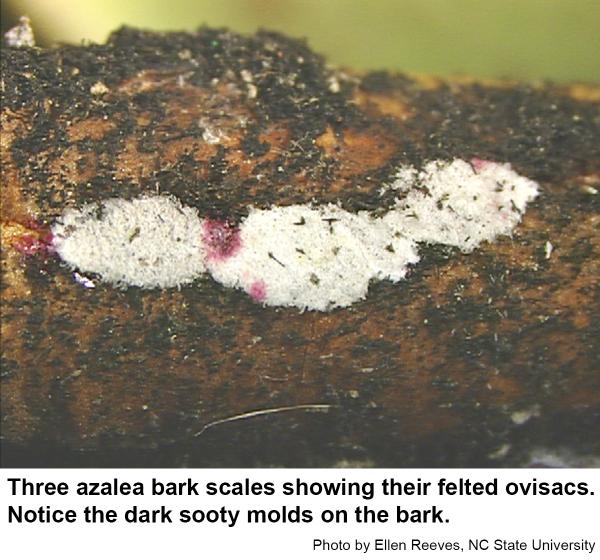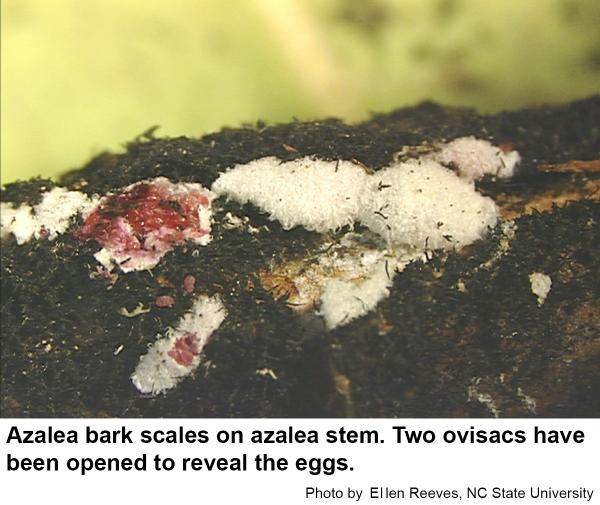Description and Biology
Adult female azalea bark scales, Eriococcus azaleae, are dark red with short legs and antennae and long, thread-like mouthparts. The insect is usually hidden from view by the egg sac or ovisac, a white covering of felted or matted waxy threads. The sac is about 1/8 inch long and 1/16 inch thick. Reddish purple eggs are laid within the egg sac, occupying the void left by the female's shrinking body. Eggs are laid in late April. They hatch about 3 weeks later in early May. This new generation matures during the summer and produces eggs that hatch in September. Newly hatched nymphs, called crawlers, are tiny and crawl out of the egg sac onto the bark where they settle especially near twig crotches. Crawlers soon penetrate the bark with long, thread-like mouthparts, begin to feed by sucking out sap. They then begin excreting honeydew. These nymphs are inconspicuous and practically free of any waxy covering. Mature females tend to feed in crotches and on twigs. Adult males have two wings and are tiny. Males tend to feed on leaves. Azalea bark scales overwinter as nymphs feeding through the bark.
Host Plants
Infested plants often become darkened with sooty molds, fungi that grow in the honeydew excreted by these sucking pests. Infested azaleas also become yellowish and unthrifty. The azalea bark scale has been reported from andromeda, four azalea species, blueberry,"flowering cherry," hawthorn, huckleberry, poplar, rhododendron, and willow.
Residential Recommendations
Chemical control of the azalea bark scales and their eggs in the ovisacs is difficult with insecticide sprays. However, after the eggs hatch, the tiny, new nymphs are exposed on the bark and relatively vulnerable. Late spring and late summer are the two best times to treat. Imidacloprid, pyrethroids, or summer oil should give adequate control of the nymphs, especially nymphs that have not secreted the white, matted covering.
References
- Azalea Bark Scale. Rosetta, R. 2006. Pacific Northwest Nursery IPM. Oregon State University.
- Azalea Pest Management Calendar. Baker, J. R. 2008. Entomology Insect Notes, NC State Extension Publications
- Insect and Related Pests of Shrubs. Baker, J. R. ed. 1980. NC Agricultural Extension Service publication AG-189. 199 pp.
- Extension Plant Pathology Publications and Factsheets
- Horticultural Science Publications
- North Carolina Agricultural Chemicals Manual
For assistance with a specific problem, contact your local N.C. Cooperative Extension Center
This Factsheet has not been peer reviewed.
Publication date: April 21, 2016
Revised: Aug. 29, 2019
Recommendations for the use of agricultural chemicals are included in this publication as a convenience to the reader. The use of brand names and any mention or listing of commercial products or services in this publication does not imply endorsement by NC State University or N.C. A&T State University nor discrimination against similar products or services not mentioned. Individuals who use agricultural chemicals are responsible for ensuring that the intended use complies with current regulations and conforms to the product label. Be sure to obtain current information about usage regulations and examine a current product label before applying any chemical. For assistance, contact your local N.C. Cooperative Extension county center.
N.C. Cooperative Extension prohibits discrimination and harassment regardless of age, color, disability, family and marital status, gender identity, national origin, political beliefs, race, religion, sex (including pregnancy), sexual orientation and veteran status.


